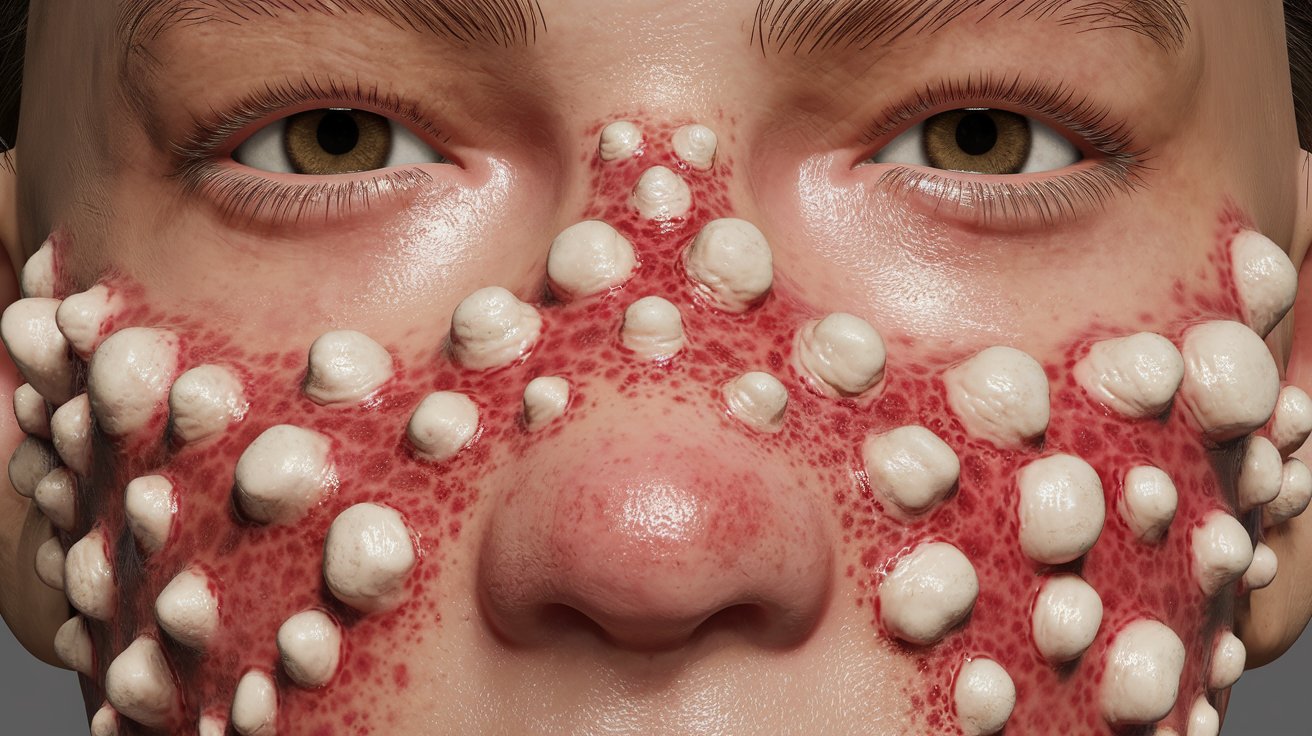
Nevoid Basal-Cell Carcinoma Syndrome (NBCCS), also known as Gorlin Syndrome, is a rare genetic disorder that affects multiple organ systems. This condition, inherited in an autosomal dominant pattern, means a single copy of the mutated gene can cause the disorder. NBCCS is primarily linked to mutations in the PTCH1 gene, which plays a crucial role in the hedgehog signaling pathway. Individuals with this syndrome often develop various symptoms, including basal cell carcinomas, jaw tumors, and skeletal abnormalities. Despite its rarity, with a prevalence of 1 in 50,000 to 1 in 100,000, understanding NBCCS is vital for early diagnosis and effective management. This article will explore 30 essential facts about Nevoid Basal-Cell Carcinoma Syndrome, shedding light on its complexities and the importance of comprehensive care.
Key Takeaways:
- Nevoid Basal-Cell Carcinoma Syndrome (NBCCS), also known as Gorlin syndrome, is a rare genetic disorder that increases the risk of developing skin cancer and other tumors. It affects multiple organ systems and can have a wide range of symptoms.
- While there is no cure for NBCCS, early detection and intervention can significantly improve outcomes. Treatment options include surgical removal of tumors, medications, radiation therapy, and genetic counseling for families. An interprofessional team approach is crucial for managing this complex condition.
What is Nevoid Basal-Cell Carcinoma Syndrome?
Nevoid Basal-Cell Carcinoma Syndrome (NBCCS), also known as Gorlin syndrome, is a rare genetic disorder. It affects multiple organ systems and increases the risk of developing certain cancers, particularly basal cell carcinoma of the skin. Let's dive into some key facts about this condition.
-
Definition and Synonyms
NBCCS is also referred to as Gorlin syndrome or Gorlin-Goltz syndrome. It is an autosomal dominant familial cancer syndrome. -
Prevalence
This syndrome is rare, with an estimated prevalence of 1 in 50,000 to 1 in 100,000 individuals.
Genetic Basis and Inheritance
Understanding the genetic underpinnings of NBCCS is crucial. It helps in diagnosing and managing the condition effectively.
-
Genetic Basis
The PTCH1 gene is primarily linked to NBCCS. This gene encodes a receptor involved in the hedgehog signaling pathway. Mutations in PTCH1 are responsible for most cases, though SUFU and PTCH2 gene mutations can also cause similar symptoms. -
Inheritance Pattern
NBCCS follows an autosomal dominant inheritance pattern. A single copy of the mutated gene can cause the condition. Each child of an affected parent has a 50% chance of inheriting the mutated gene. -
De Novo Mutations
About 20-30% of NBCCS cases result from de novo mutations. These mutations occur for the first time in the affected individual and are not inherited from either parent.
Clinical Features
NBCCS presents with a variety of symptoms that can vary greatly among individuals. Here are some common clinical features.
-
Basal Cell Carcinomas
These are the most common type of skin cancer in NBCCS and often develop during adolescence or early adulthood. -
Keratocystic Odontogenic Tumors
Noncancerous tumors of the jaw, typically appearing during puberty. They can cause painful facial swelling and tooth displacement if untreated. -
Palmar and Plantar Pits
Small depressions in the palms of the hands and soles of the feet are characteristic of NBCCS. -
Skeletal Abnormalities
These include bifid ribs, wedge-shaped vertebrae, and other skeletal defects often visible only with X-rays. -
Facial Features
Distinctive facial features may include hypertelorism (wide-set eyes), macrocephaly (larger-than-average head size), and milia (tiny white cysts embedded in the skin).
Tumors and Other Complications
NBCCS increases the risk of developing various tumors and other complications. Here are some of the most significant ones.
-
Brain Tumors
Individuals with NBCCS have an increased risk of developing brain tumors, including medulloblastoma, a type of childhood brain tumor. -
Heart Tumors
Heart tumors, specifically cardiac fibromas, can occur. These tumors are usually benign but can cause symptoms like arrhythmia or obstruct blood flow. -
Ovarian Tumors
Ovarian fibromas are another type of tumor that can occur in women with NBCCS. These tumors are generally benign and do not affect fertility. -
Eye Problems
NBCCS can lead to various eye problems, including cataracts, glaucoma, and other ocular abnormalities. -
Deafness
Some individuals may experience hearing loss or deafness due to inner ear abnormalities. -
Intellectual Disability
While not universal, intellectual disability can occur in some individuals, often due to associated brain abnormalities. -
Seizures
Seizures can arise from brain abnormalities or other neurological issues.
Skeletal and Bone Defects
NBCCS often affects the skeletal system, leading to various bone defects and abnormalities.
-
Bone Defects
NBCCS can lead to scoliosis (curvature of the back) and kyphosis (severe curvature of the back). -
Abnormal Ribs
Affected individuals may have abnormal ribs, such as bifid ribs that are split into two pieces. -
Skeletal System Involvement
The skeletal system is often affected, with abnormalities ranging from mild to severe, including various types of bone deformities.
Treatment and Management
While there is no cure for NBCCS, various treatments can manage its symptoms and prevent complications.
-
Surgical Removal of Tumors
Basal cell carcinomas and keratocystic odontogenic tumors can be surgically removed to prevent further growth. -
Medications
Topical treatments like smoothened inhibitors can treat basal cell carcinomas. -
Radiation Therapy
In some cases, radiation therapy may be necessary to treat aggressive tumors. -
Genetic Counseling
Genetic counseling is crucial for families affected by NBCCS to understand the risks and make informed decisions about family planning.
Prognosis and Family History
The prognosis for individuals with NBCCS varies widely. Early detection and intervention can significantly improve outcomes.
-
Prognosis
The prognosis depends on the severity of symptoms and the effectiveness of treatment. -
Family History
A family history of NBCCS is often present, but individuals can develop the condition without a known family history due to de novo mutations.
Diagnostic Tests and Management Strategies
Diagnosis and management of NBCCS involve a combination of clinical evaluation and genetic testing.
-
Diagnostic Tests
Key diagnostic tests include genetic testing for mutations in the PTCH1, SUFU, and PTCH2 genes, imaging studies to evaluate skeletal abnormalities and detect tumors, and biopsy to confirm the presence of tumors. -
Management Strategies
Management strategies focus on preventing and treating tumors, addressing skeletal abnormalities, and managing associated complications. An interprofessional team approach is often necessary.
Support and Future Directions
Support and ongoing research are essential for improving outcomes and supporting families affected by NBCCS.
-
Interprofessional Team
An interprofessional team including dermatologists, oncologists, neurologists, orthopedic surgeons, and geneticists is essential for managing NBCCS. -
Future Directions
Future directions include personalized medicine approaches, where treatments are tailored to individual genetic profiles. Comprehensive support systems for affected families, including psychological support and educational resources, are also needed.
Understanding Nevoid Basal-Cell Carcinoma Syndrome
Nevoid Basal-Cell Carcinoma Syndrome (NBCCS) is a complex genetic disorder with a wide range of symptoms and complications. From basal cell carcinomas to skeletal abnormalities and brain tumors, the condition affects multiple organ systems. Early diagnosis and a multidisciplinary approach to treatment can significantly improve outcomes. Genetic counseling plays a crucial role in helping families understand the risks and make informed decisions. Regular skin checks, dental evaluations, and imaging studies are essential for early detection of tumors and other complications. While there’s no cure, various treatments like surgical removal of tumors, medications, and radiation therapy can manage symptoms effectively. Ongoing research aims to develop better treatments and improve the quality of life for those affected. Raising awareness and providing support are key to helping individuals and families navigate the challenges of NBCCS.
Frequently Asked Questions
Was this page helpful?
Our commitment to delivering trustworthy and engaging content is at the heart of what we do. Each fact on our site is contributed by real users like you, bringing a wealth of diverse insights and information. To ensure the highest standards of accuracy and reliability, our dedicated editors meticulously review each submission. This process guarantees that the facts we share are not only fascinating but also credible. Trust in our commitment to quality and authenticity as you explore and learn with us.


